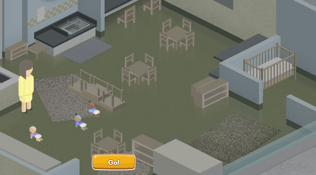Blog
Integrating Gaming and e-Learning Design
Games Are Trending “Award badges.” “Make people really think through decisions.” “Make it fun, like Angry Birds.” Instructional designers now hear ...


Integrating Gaming and e-Learning Design Part I of 3: An ID-Based Model
By Edmond Manning and Ellen Burns-Johnson | November 28, 2017 | Custom Learning | 0 Comments
Games Are Trending
“Award badges.”
“Make people really think through decisions.”
“Make it fun, like Angry Birds.”
Instructional designers now hear these gamifying requests from trend-savvy stakeholders who want to harness the power of games. Why badges? They’re not sure. What will an Angry Birds approach accomplish? Don’t know. Maybe more fun?
Instructional designers must delicately explain you can’t just “award badges” and assume it’s more meaningful to adult learners. Gamification and game-based learning can be powerful stuff, but these strategies are unlikely to have powerful effects when they’re randomly applied.
But how to integrate game-based strategies/gamification in a way that achieves outcomes?
Traditional ID programs (workshops, accredited programs, university degrees) don’t often harness game theory or integrate design strategies from game-based designs, unless that’s a focus of their program. Those who learned from traditional programs, face the “how do we integrate” challenge without guidance.
Typical Gamification responses
There are any number of approaches instructional designers take:
-
Think of games they themselves like to play and adapt those elements.
-
Look at the scope (budget and time) and ask, “What can we afford to create?”
-
Ask developers “Given our development tool, what’s possible?”
-
Advocate off-the-shelf templates where someone else has “gamified” multiple choice questions.
-
Badly adapt the television show Jeopardy to an online experience. (And since nobody has the property rights to Alex Trebek’s name, there’s always some cringe-worthy-don’t-sue-us-imitation-name, like, “Talex Quebec.” Ugh. Stop doing that.)
These are terrible approaches.
At Online Learning 2017 in New Orleans, my colleague and I, Ellen Burns-Johnson, debuted a road map for how to address this gaming black hole. We outlined a process we’d like to share with you.
A process based on instructional design
It’s astonishing how once a new trend emerges (gamification, microlearning, social media integration) instructional designers abandon principles of our field. They adopt the trend armed with nothing more than hope.
“Break the learning into smaller chunks! Now it’s microlearning!”
“People want to have fun while learning. Call each part of the quiz a ‘level’ so it’ll feel like a game!”
Hope is not a strategy.
Instructional design’s ideology is this: to achieve any desired results, you have to map out how to get there, once you establish where “there” is. That’s it. That’s the radical notion. No learning trend has ever come along to unseat the power of that process. This approach is used by professional basketball players who study three-point shots, bakers baking cakes, and anyone building a four-lane bridge. You strategize the desired outcome, then figure out how to make it reality.
Our model harnesses this same premise: you must start with what you want to achieve if you hope to ever uncover which gaming elements will bring about success.

Articulate Project Goals, Define Desired Performance
Start with the project goals. They are the “there” when determining where it is you wish to go. Examples of project goals might be:
-
“We want this online app shared 22,000 times.”
-
“Complete this project in two months.”
-
“We need everyone in Production department to finish this by Q3 to meet OSHA standards.”
-
“We need everyone to pass the post-assessment with at least 80%.”
-
“Better understanding of our industry.”
We’ve all seen variations of these statements, the kinds of phrases that make a top executive or stakeholder decide if the project was successful. Why would you ever NOT start here, no matter what kind of trend you were incorporating? These are how your success will be measured!
Next, determine the relationship between the project goals and the desired performance. The question one must answer is this: if the associated performance is achieved, will that bring about the project goal?
For example, consider the first project goal above: “We want this online app shared 22,000 times.” Straight forward, right? It could be achieved a number of ways:
-
1,000 people share 22 times.
-
22,000 share one time.
-
11,000 share twice.
However one crunches the numbers, the necessary performance is the same: the learner chooses to share the online app. If a significant number of learners do not share, how are we going to reach that 22,000 number? We have to focus on that: getting every learner to share the app. That’s the performance. (We may also have to strategize how to get the app in front of 22,000 people, but that’s a different project goal.)
If the performance identified was “the learner writes a review of the online app,” would that achieve the project goal of 22,000 shares? Nope. Choosing to share—an affective goal—is much more elusive and difficult to achieve than a cognitive goal, like writing a review. We, as instructional designers, have to be frank with our stakeholders: we can name the desired performance to achieve the project goal, but it might mean more work than they originally thought.
Let’s look again at our process graphic:

The relationship of that first column (articulating project goals) to the second column (define performance outcomes) is surprisingly complex. If the project goal is “increase sales by 15%,” before naming the desired performance, you’d need proof that learners’ lack of knowledge or lack of performance has a direct impact on sales (to the tune of 15%). If that relationship can be proven, “increase sales” can be addressed through training. That’s no small relationship to prove!
The point we wish to make is that it’s tough—proving the desired behavior will lead to the project goal, but if there’s no correlation, how could you ever think you’d be successful?
So far, we’ve done nothing related to gaming—this is standard instructional design. But now, it’s time to discuss gaming terminology that impacts our model.
Mechanics, Dynamics, and Aesthetics
Mechanics are the agents, objects, elements, and their relationships in the game. In the game of Monopoly, this is everything from the silver top hat and other trinkets you clomp around the board, to the board itself, the property cards, the fake money, the rules for advancement, etc. Everything.
Dynamics are a little trickier concept to grasp. According to “MDA: A Formal Approach to Game Design and Game Research” by Robin Hunicke, Marc LeBlanc, and Robert Zubek, dynamics are the emergent behavior that arises from gameplay when mechanics are put into use.
Whaaaaaaaaat?
Think again of Monopoly: some players snatch up the expensive properties, hoping to extort higher rents and bankrupt their friends and family with one unfortunate roll of their dice. Other people buy many cheaper properties and quickly build hotels, hoping to get money through quantity. These are strategies. There’s nothing in Monopoly’s rules that says which strategy should lead to winning. Strategies are game dynamics that emerge when mechanics are put into use. Other Monopoly dynamics include trading properties, or calculating probabilities of landing on certain squares.
Before we move on to Aesthetics, let’s recap.
-
Mechanics are the rules, elements, and agents in the game.
-
Dynamics are how people interact with the mechanics.
Aesthetics describe the emotional responses from the players to the gameplay. In Monopoly, that might include frustration, intense boredom, or exhilaration as it becomes clear that you’re going to defeat your smug older sister who thinks she knows everything because she’s 14.
Ahem. Anyway…
“Award badges.” Badges = game mechanics.
“Make people really think through decisions.” Think through decisions =game dynamics.
“Make it fun, like Angry Birds.” Fun = game aesthetics.
Once you’re aware that all three of these distinct gaming concepts are present in every game, you realize not planning for these three means no chance of project success. After all, why bother throwing a timer or a virtual gameboard at learners if you don’t anticipate their reaction (love or hate) toward the experience? And if you don’t anticipate HOW people will play, you can’t anticipate the aesthetic.
If you’re not convinced game dynamics are crucial, you’ll love the next section.
Why everyone hates the board game Risk
Little brothers around the globe torture their sisters by repeatedly begging, “Please play Risk with me. Please!” If you’re an only child, the short version is this: Risk is a board game with an alluring premise: world domination.
The mechanics are such: you get plastic nuggets to represent military stuff: infantry, firepower, cavalry, etc. You roll dice to decide the fate of battles. The dynamics are such: roll the dice and advance. Roll the dice and advance. Roll the dice and advance. It will take you 13 hours to complete one game. By the second hour, it’s pretty clear who will emerge as victor, but still, it takes 13 hours. You have no choice but to engage the same strategy, over, and over, and over. The aesthetics are such: everyone hates playing Risk except little brothers who have thirteen hours to kill. It’s tedious. Exhausting.
Risk was designed by French filmmaker Albert Lamorisse in 1957. Perhaps the world has changed so much since then—our attention spans so much shorter—that the aesthetics worked in 1957 in a way that does do not today. The mechanics are solid, but the tedious dynamics make the aesthetics challenging. We can analyze the game with tools and language in a way that allows us to design more successful games.
The same is true of learning that tries to adopt a gaming approach. We must analyze gameplay to determine the impact on learners. If you don’t plan for mechanics, aesthetics, and dynamics when considering how learners experience your “learning game,” how will you know if the desired behavior will get achieved? If a game is badly designed, or perceived as uninteresting, players quit. Walk away. If your learning game is badly designed, learners may be forced by their LMS to complete every required click, but mentally, they quit. Walk away.
The next step in the model is to apply aesthetics, dynamics, and mechanics to the desired performance. But gosh darn, look at the imaginary clock on the wall. We’re out of time. (As the title of this post mentioned, this is the first of a three-part series utilizing this model.)
Please come back next week, when we will take a specific project through this model, clarifying how to integrate the three game concepts into instructional design.
About the Author: Edmond Manning and Ellen Burns-Johnson
Comments
Would you like to leave a comment?
Related Blog Posts

By: Edmond Manning and Ellen Burns-Johnson | Dec, 2017
Category: Custom Learning

Blog
Integrating Gaming and e-Learning Design Part 3 of 3: Getting Started
Games Are Trending “Award badges.” “Make people really think through decisions.” “Make it fun, like Angry Birds.” Instructional designers now hear ...
By: Edmond Manning and Ellen Burns-Johnson | Dec, 2017
Category: Custom Learning

Blog
Gamification: 3 Steps to Get the Recipe Right
Games Are Trending “Award badges.” “Make people really think through decisions.” “Make it fun, like Angry Birds.” Instructional designers now hear ...
By: Edmond Manning and Ellen Burns-Johnson | Sep, 2019
Category: Custom Learning, Strategic Consulting
